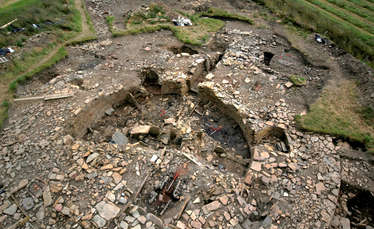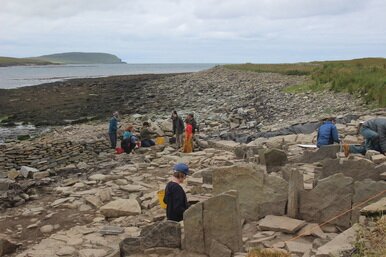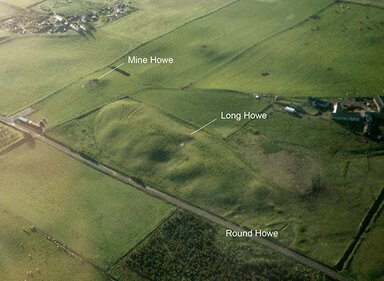Research Projects
We have a full and exciting programme of academic research in place which regularly expands our understanding and knowledge of prehistoric and historic society and culture. Current research projects include major excavations at The Ness of Brodgar surrounded by the Heart of Neolithic World Heritage Site and The Cairns in South Ronaldsay, Orkney.
|
|
The Ness of Brodgar, Orkney
Archaeological excavations have been continuing under the direction of Nick Card since 2002, In 2003, ploughing
unearthed a large slab of stone thought to be part of a 4,000 year old grave. Excavation found no bones but beautiful stone walling was revealed. Each year reveals more of the 5000 year old Neolithic structures. In 2014 the site was nominated by Archaeology Scotland for a British Archaeology Award. Click through to the Ness of Brodgar website for more details. "World's most spectacular Neolithic dig...the most significant archaeological discovery of my lifetime." Neil Oliver, BBC Presenter and Archaeologist. |
The Cairns, South Ronaldsay, Orkney
The Cairns excavation has revealed an extensive settlement that has been occupied over several centuries from the late Bronze Age through to the Viking period. The main structure on the site appears to be a well-preserved Iron Age broch or roundhouse. The finds indicate a rich material culture which depended on networks of social relations with neighbouring communities. Among the questions which we will be addressing this season include: How were brochs used? Were they the residences of the elite or communal expressions of an entire community. Site director is Martin Carruthers. Click through to our blog for more details on The Cairns.
|
Newark Bay, Deerness, Orkney
The stretch of coastline at Newark Bay, situated on the South Coast of Deerness, Orkney Island East Mainland has long been known to yield human remains from coastal section. In addition to individual skeletons, a number of structural remains, including two ‘souterrains’, several phases of structures thought to be a chapel and remains of a 16th Century manor were known to be present. Research conducted by ORCA has enabled the significance of the heritage assets, currently subject to coastal erosion, to be established. Work is ongoing at the site.
|
Skaill and Swandro
The excavations at Skaill and Swandro, on the island of Rousay, involved an international team from the UK and the USA undertaking research on multi period sites that were threatened by severe sea erosion. The digs also involved a community dimension in which local school children and volunteers were invited to take part in the process. Despite the isolated situation of the site, the open day was also a success with over 100 people visiting the sites. To see a digital dig diary for both excavations see our blog
Mine Howe
Directed by Prof. Jane Downes and Nick Card, the investigations of this Iron Age ritual site utilised large scale geophysical survey, extensive excavation as well as augering and landscape survey, to reveal unparalleled evidence for
in-situ Iron Age metalworking (ferrous and non-ferrous) situated immediately outside the monumental stone-revetted ditch which in turn surrounded the complex underground structure of Mine Howe. Early (Iron Age) evidence of the creation of plaggen soils (type of soil created as a result of plaggen agriculture where grass was used as bedding and then spread over the fields as fertiliser) is also attested at this site. The existence of an agglomeration of the ritual sites of Mine Howe, Round Howe, and the site of an early chapel within the Mine Howe environs, together with the finding of many unusual artefacts and human remains are features which call to mind Irish royal sites, such as Tara, and Knowth, and offer rich scope for further research planned into Celtic and Nordic mythologies and affinities. |
Giving the past a presence now and for the future
Orkney Research Centre for Archaeology, University of the Highlands and Islands Archaeology Institute,
Orkney College UHI, Kirkwall KW15 1LX.
T: E:
Orkney College UHI, Kirkwall KW15 1LX.
T: E:
Copyright © 2018









